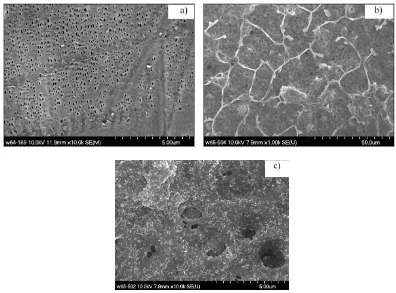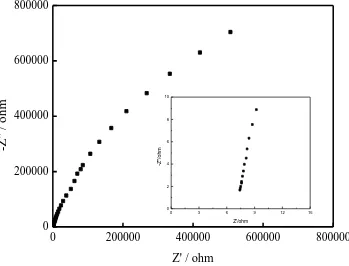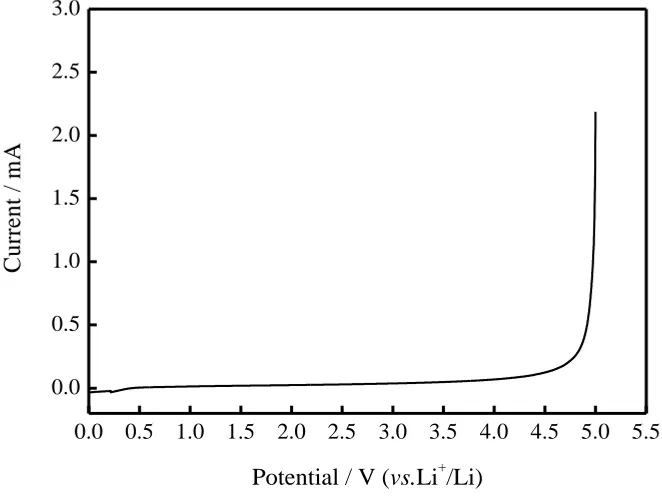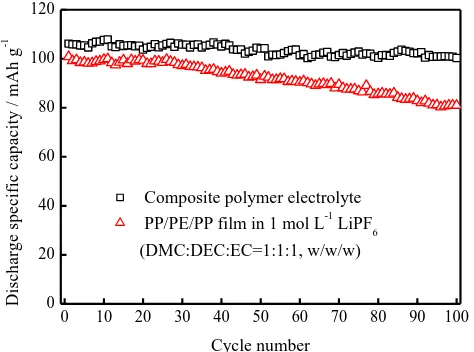Int. J. Electrochem. Sci., 7 (2012) 12601 - 12609
International Journal of
ELECTROCHEMICAL
SCIENCE
www.electrochemsci.orgPVDF-based Comoposite Polymer Electrolyte for Li/LiFePO
4Batteries
Lilai Liu1, Peixia Yang2,*, Lei Liu2, Wen-yu Cui2, Mao-zhong An2
1
Engineering Research Academy of Graphite New Materials, Heilongjiang Institute of Science and Technology, Harbin 150027, China
2
School of Chemical Engineering and Technology, Harbin Institute of Technology, Harbin 150001, China
*
E-mail: yangpeixia@hit.edu.cn
Received: 22 October 2012 / Accepted: 16 November 2012 / Published: 1 December 2012
In order to improve the mechanical strength of the PP/PE/PP membrane, a novel polymer membrane was prepared by introducing nano-SiO2 filled PVDF polymer film. After soaking the liquid electrolyte
(1 mol L-1 LiPF6 (DMC:DEC:EC=1:1:1, w/w/w)), the composite polymer electrolyte was obtained and
used as the electrolyte for Li/LiFePO4 batteries.The properties of the composite polymer
film/electrolyte were characterized by scan electronic microscopy, material test machine, scan voltammetry, electrochemical impedance spectroscopy, constant current charge/discharge test. The results showed that the composite polymer film owns higher electrolyte absorption ability (145 % absorbance) and improved mechanical strength than that of PP/PE/PP film. The ionic conductivity reached 1.12×10-3
Scm-1, and its electrochemical stability window is about 4.5V. At 60℃, the capacity retention of Li/LiFePO4 batteries with the obtained composite polymer electrolyte as electrolyte was
98 % after 100 cycles even at 1C. The excellent cyclability of Li/LiFePO4 batteries at high temperature
showed that the obtained composite polymer electrolyte could be a possible electrolyte candidate for Li/LiFePO4 batteries used for electric vehicles and hybrid electric vehicles.
Keywords: Composition; Polymer electrolyte; Electrochemical properties; Mechanical properties; Li/LiFePO4 batteries
1. INTRODUCTION
batteries contained the standard liquid electrolyte can meet most needs of the applications, the leakage is inevitable due to the fluidity nature of the liquid, especially in abuse conditions. On the other hand, the rigid package has to be adopted because of the liquid electrolyte, thus the weight specific energy of the lithium ion batteries will be limited. On the contrary, the polymer electrolytes can pack flexibly and eliminate leakage, which is attractive for safety improvement of lithium ion batteries. And the significant advantages in weight, volume specific capacity and the packaging cost can also be obtain by using polymer electrolytes[1-4]. So, more attentions are paid to the polymer electrolyte with acceptable ion conductivity by soaking the porous polymer film with organic liquid electrolyte[5-7]. Recently, LiFePO4 is considered as one of the most suitable cathode material applied in Electric
Vehicle(EV) and Hybrid Electric Vehicles(HEV) due to advantages such as low cost, good cycling performance at room temperature, high safety, non-toxicity and environmental friendliness[8,9]. However, though some efforts have been made to enhance the mechanical strength of the polymer electrolyte, such as introducing the inorganic metallic oxides Al2O3, SiO2, TiO2 and so on as the filling
stuff[10,11], the mechanical strength of the polymer electrolyte is still not satisfied for the Li/LiFePO4
batteries, especially during long cycled at high temperature.
In this paper, a PVDF-based composite polymer film with nano-SiO2 filling stuff by
incorporating the PP/PE/PP film to enhance the mechanical strength. After further soaking with standard electrolyte (1 mol L-1 LiPF6 (DMC:DEC:EC=1:1:1, w/w/w)), the composite polymer
electrolyte for Li/LiFePO4 batteries was obtained. The composite polymer electrolyte was found to
reveal excellent electrochemical properties and could be a promising electrolyte candidate for Li/LiFePO4 batteries applied in EV and HEV fields.
2. EXPERIMENTAL
2.1 Materials
dibuty(o-)phthalate (DBP) and acetone was purchased from Tianjin Kermel Chemical Reagent Co., Ltd., China. LiFePO4 was purchased from Changes scending Ent., Taiwan. N-methylpyrrolidone
(NMP) was purchased from Tianjin Ruijinte Chemical Co., Ltd., China.Aforementionedreagents were used of analytical grade. Other materials were obtained from Zhejiang dongsheng energy technology development Co. Ltd.China.
2.2 Preparation of the PVDF-based composite polymer electrolyte
The PVDF polymer solution with nano-SiO2 filling stuff was prepared as follows: PVDF
powder was dried at 80℃ under vacuum for 12 hours before use. Then the PVDF powder、DBP and nano-SiO2 powder (1.5:1:1.1 in weight) were mixed and dissolved in acetone, stirring homogeneously
(DMC:DEC:EC=1:1:1, w/w/w)) for 1 hour to obtain the composite polymer electrolyte. The excess liquid electrolyte on the surface of the film was removed by filter paper to get the composite polymer electrolyte.
2.3 Measurements of the PVDF-based composite polymer electrolyte
The morphologies of the dried composite polymer and the commercial PP/PE/PP films were observed by scanning electron microscopy (SEM, HITACHI S-4700).
The electrolyte absorbing ability (Sw) of the dried composite polymer film was evaluated by
equation (1):
0
100( )
w
w w S
w
(1)
where w0 is the mass of dried composite polymer film and w is the mass of composite polymer
electrolyte.
The mechanical strength of the dried composite polymer film was measured by material test machine (USA Instron5569).
The ionic conductivity (σ) of the composite polymer electrolyte was obtained by electrochemical impedance spectroscopy (EIS) in configuration of blocking cells (SS/composite polymer electrolyte/SS, SS=stainless steel) within the frequency of 100k~0.01 Hz at the amplitude of 5 mV by electrochemical analyzer (CHI604b). The ionic conductivity (σ) was calculated according to the equation (2):
b
l
AR
(2)where Rb is the bulk resistance obtained from the intercept of the Nyqiust plot with the real axis,
l is the thickness of the composite polymer electrolyte and A is the electrode area (0.79 cm2).
The electrochemical stability window of the composite polymer electrolyte was tested in three-electrode cell (SS as working three-electrode, Li metal as counter and reference three-electrode) by electrochemical analyzer (CHI660a) via linear scan voltammetry (LSV) technique in potential range of 0~5.5 V at the scan rate of 5 mV s-1
.
The charge-discharge behavior of the 2025-type coin cells (Li/LiFePO4) tests were conducted
at 60℃ using a oven thermostat. The tests were performed at the constant current mode, cycled at 1 C over the range of 2.7~4.2 V by Neware battery testing system.
2.4 Battery assembly
composite polymer electrolyte was used as both electrolyte and separator. For comparison, the commercial PP/PE/PP film soaked with standard electrolyte (1 mol L-1 LiPF6 (DMC:DEC:EC=1:1:1,
w/w/w)) was also used as both electrolyte and separator in the same cell configuration. Cathode electrodes were prepared by mixing 80 wt% LiFePO4 material power, 10 wt% PVDF and 10wt%
acetylene black in N-methylpyrrolidone (NMP) solvent. The mixed slurry was then coated onto aluminum foil. After vacuum drying at 120℃ for 24 h, the dried electrode was cut into disks and compressed by a roller at room temperature to make a smooth and compact electrode structure. Disks of similar surface area, thickness and weight were selected and stored in an argon-filled glove box.
3. RESULTS AND DISCUSSION
3.1. Physical properties characterization
Fig. 1 shows the SEM images of the PP/PE/PP film and the dried composite polymer film. The PP/PE/PP film (Fig. 1 (a)) owns the porous structure with small pores distributed homogenously. After coated with the polymer, the surface is covered by the transparent polymer layer and the porosity nature of the PP/PE/PP film still exists (Fig. 1 (b)). The image of the polymer coating is magnified in Fig. 1 (c), the spongy and porous features of the polymer layer are obviously obtained, which will be beneficial for the ability of absorbing the electrolyte.
[image:4.596.99.495.429.722.2]
Before soaking the electrolyte, the weight (w0) of the dried composite polymer film is 14.7 mg
and the thickness is 48µm which is a little thicker than the PP/PE/PP film (34 µm). After soaking, the weight increases to 36.0 mg (w) and the thickness expands to 63 µm (l). By application of equation (1), the absorptance is calculated to be 145 %, which is larger than the 130 % of the PP/PE/PP film (whose w0 and w is 14.4 mg and 33.1 mg respectively). This enhanced absorptance is supported by the spongy
and porous features of the morphology observed in SEM images.
[image:5.596.183.411.231.415.2]Fig. 2 shows the plot of the mechanical strength test and the parameters are summarized in Table 1.
0 3 6 9 12 15
0.00 0.02 0.04 0.06 0.08 0.10
L
o
a
d
/
k
N
Displacement / mm
Figure 2. Mechanical strength test of the dried composite polymer film
Table 1. Mechanical strength parameters
Lengthways pull stress Maximal
load
Maximal displacement
Area Pull strength
Dried composite polymer film 82.80 N 13.82 mm 7.5×10-7 m2 110.40 MPa
PP/PE/PP film 88.84 N 3.84 mm 1.0×10-6 m2 88.84 MPa
The maximal lengthways pull strength is the most important factor to evaluate the mechanical properties. As is shown in Table 1, the maximal lengthways pull strength of the composite polymer film is 110.40MPa, which is larger than that of PP/PE/PP film (88.84 MPa). By simple treated with the commercial PP/PE/PP film, the improved mechanical strength is obtained, which will be beneficial for the cycling performance of Li/LiFePO4 batteries. As we all know,the maximal displacement
3.2 Electrochemical characterization
Fig. 3 shows the Nyqiust curve of the SS/composite polymer electrolyte/SS blocking cell. The measured Nyquist plot exhibits an approximately straight line from real axis, which reflects that Li+ conductivity is mainly dependent on the liquid electrolyte encapsulated in the polymer film matrixes. From the intercept of the plot on the real axis, the value of Rb is found to be 7.42 Ω, thus the value of σ
is 1.12×10-3
S cm-1, which is comparative to the standard electrolyte for lithium ion batteries. In the previous reports, the ionic conductivity of some polymer electrolyte rarely reached 10-3 S cm-1 at room temperature[12-14]. The increased ionic conductivity of the composite polymer electrolyte is attributed to the improved ion transport properties of the composite polymer layer which is able to widen the ion-conductive pathways.
0 200000 400000 600000 800000
0 200000 400000 600000 800000
0 3 6 9 12 15
0 2 4 6 8 10
-Z
''/
o
h
m
Z'/ohm
-Z
''
/
o
h
m
[image:6.596.124.473.289.555.2]Z' / ohm
Figure 3. Nyquist plot of the blocking cell (SS/composite polymer electrolyte/SS)
Fig. 4 plots the LSV of the composite polymer electrolyte and there is no anodic spikes observed from 0V to 4.5V. The electrochemical stability window of the composite polymer electrolyte is about 4.5 V, which means that various cathodes, from relative low voltage to high voltage species, can be assembled with this composite polymer electrolyte. LiFePO4 cathode material has the most
suitable characteristics for application as EV and HEV batteries in terms of cost and stability. The work voltage of the LiFePO4 is 3.4V[15], and the prepared composite polymer electrolyte can be
0.0 0.5 1.0 1.5 2.0 2.5 3.0 3.5 4.0 4.5 5.0 5.5
0.0 0.5 1.0 1.5 2.0 2.5 3.0
C
u
rr
en
t
/
m
A
[image:7.596.129.460.77.326.2]Potential / V (vs.Li+/Li)
Figure 4. LVS diagrams of the composite polymer electrolyte
Fig.5(a) shows the initial voltage profiles of the Li/LiFePO4 battery assembled with the
composite polymer electrolyte. And the initial voltage profiles of the Li/LiFePO4 battery assembled
with the commercial PP/PE/PP film soaked with standard electrolyte (1 mol L-1 LiPF6
(DMC:DEC:EC=1:1:1, w/w/w)) is present in Fig.5(b).
0 10 20 30 40 50 60 70 80 90 100 110
2.6 2.8 3.0 3.2 3.4 3.6 3.8 4.0 4.2
V
o
lt
a
g
e
/
V
Specific capacity / mAh g-1
0 10 20 30 40 50 60 70 80 90 100 110
2.6 2.8 3.0 3.2 3.4 3.6 3.8 4.0 4.2
V
o
lt
a
g
e
/
V
Specific capacity / mAh g-1
(a) (b)
Figure 5. Initial voltage profile of the Li/LiFePO4 cell. (a) PP/PE/PP film in 1 mol L-1 LiPF6
(DMC:DEC:EC=1:1:1, w/w/w) used as the electrolyte, (b) composite polymer electrolyte used as the electrolyte
[image:7.596.80.518.481.661.2]
capacity of the cell with the composite polymer electrolyte is 106.10 mAh g-1, which is a little more than the cell with the PP/PE/PP film (soaked with the 1 mol L-1 LiPF6 in DMC:DEC:EC=1:1:1, w/w/w)
[image:8.596.54.545.226.346.2](the initial charge capacity is 100.83). The coulombic efficiency is 95.6 % and 96.1 % for the cells with the two kinds of the electrolytes, respectively. These indicate that the composite polymer electrolyte obtained by simply treating the commercial PP/PE/PP film does not have any adverse effect on either initial capacity or coulombic efficiency.
Table 2. Parameters of the initial voltage profiles of the Li/LiFePO4 in different electrolyte
Electrolyte Charge specific
capacity / mAh g-1
Discharge specific
capacity / mAh g-1
Coulombic efficiency / %
composite polymer electrolyte
106.10 101.41 95.6
PP/PE/PP film soaked with 1 mol L-1 LiPF6 in
DMC:DEC:EC=1:1:1, w/w/w
100.83 96.93 96.1
Because the battery applied in EV and HEV always needs to work at high temperature, the characterization of high temperature performance is of significance for electrolyte. Fig. 6 compares the variation of discharge specific capacity vs. cycle number obtained from Li/LiFePO4 cells at 60℃. The
cell with the commercial PP/PE/PP film displays around 17 % capacity loss at the 100th cycle, which is better than that reported newly in Ref. 11. The cell with composite polymer electrolyte displays only around 2 % capacity loss at the 100th cycle, which is preferable compared with open reports. These indicate that prepared composite polymer electrolyte could be treated as the possible electrolyte candidate for Li/LiFePO4 batteries.
0 10 20 30 40 50 60 70 80 90 100
0 20 40 60 80 100 120 D is c h a rg e s p e c if ic c a p a c it y / m A h g -1 Cycle number Composite polymer electrolyte PP/PE/PP film in 1 mol L-1 LiPF6 (DMC:DEC:EC=1:1:1, w/w/w)
Figure 6. Cycle performance of the Li/LiFePO4 cell. (a) PP/PE/PP film in 1 mol L-1 LiPF6
[image:8.596.181.418.526.702.2]
4. CONCLUSIONS
The composite polymer film was prepared by coating commercial PP/PE/PP film with PVDF-based polymer, SiO2 and the composite polymer electrolyte was obtained by immersing the composite
polymer film into the standard electrolyte (1 mol L-1 LiPF6 (DMC:DEC:EC=1:1:1, w/w/w). The
mechanical strength and the absorbing ability of the prepared composite polymer film is enhanced greatly by simple treated with the commercial PP/PE/PP film. And the treatment does not have any adverse effect on either ionic conductivity or initial capacity. Meanwhile, the Li/LiFePO4 batteries
with the obtained composite polymer electrolyte exhibit excellent capacity retention even after 100 cycles galvanostatically at 60 ℃. These demonstrate that the prepared composite polymer electrolyte could be a promising electrolyte candidate for Li/LiFePO4 batteries used in electric vehicles and hybrid
electric vehicles.
ACKNOWLEDGEMENTS
The work is supported by Project of National Nature Science Foundation of China (No. 21276057) and Natural Scientific Research Innovation Foundation in Harbin Institute of Technology (No. HIT. NSRIF. 2009121).
References
1. Z. Jiang, B. Carroll and K. M. Abraham, Electrochim. Acta, 42 (1997) 2667 2. F. B. Dias, L. Plomp and J. B. J. Veldhuis, J. Power Sources, 88 (2000) 169 3. A. M. Stephan, J. European Polymer, 42 (2006) 21
4. N. Ataollahi, A. Ahmad, H. Hamzah, M. Y. A. Rahman and N. S. Mohamed, Int. J. Electrochem. Sci.,7 (2012) 6693
5. G. Vijayakumar, S. N. Karthick, A. R. S. Priya, S. Ramalingam and A. Subramania, J. Solid State Electr., 12 (2008) 1135
6. P. Zhang, G. C. Li, H. P. Zhang, L. C. Yang and Y. P. Wu, Electrochem. Commun., 11 (2009) 161 7. J. W. Zhang, X. B. Huang, H. Wei, J. W. Fu, Y. W. Huang and X. Z. Tang, Electrochimi. Acta, 55
(2010) 5966
8. N. Iltchev, Y. K. Chen, S. Okada and J. Yamaki, J. Power Sources, 119 (2003) 749
9. L. B. Song, X. H. Li, Z. X. Wang, X. H. Xiong, Z. L. Xiao and F Zhang, Int. J. Electrochem. Sci., 7 (2012) 6571
10. S. Ahmad and S. A. Agnihotry, Curr. Appl. Phys., 9 (2009) 108
11. S. Ahmad, H. B. Bohidar, S. Ahmad and S. A. Agnihotry, Polymer, 47 (2006) 3583 12. J. H. Shin, W. A. Henderson and S. Passerini, Electrochem. Commun., 5 (2003) 1016
13. J. H. Shin, W. A. Henderson, G. B. Appetecchi, F. Alessandrini and S. Passerini, Electrochim. Acta, 50 (2005) 3859
14. H. Cheng, C. Zhu, B. Huang, M. Lu and Y. Yang, Electrochim. Acta, 52 (2007) 5789 15. C. C. Chang and T. K. Chen, J. Power Sources, 193 (2009) 834




